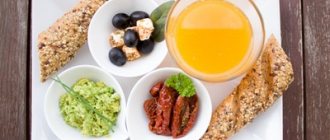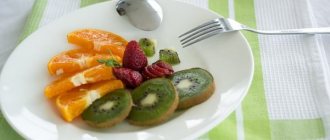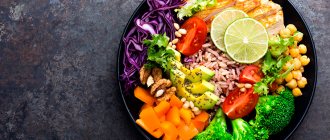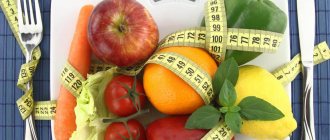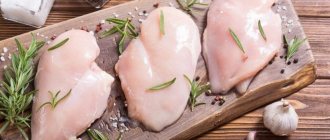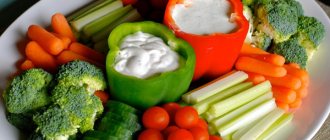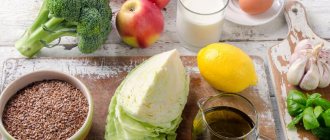A diet for weight loss according to the proper nutrition system (PN) can be treated differently. You can criticize and find flaws in it, or fanatically adhere to it all your life, enjoying your appearance. But the fact that the PP system is effective and has helped thousands of fat people who have given up is a fact proven by time and confirmed by nutritionists.
Proper nutrition is not only about cabbage salads and steamed fish. Millions of recipes for breakfast, lunch and dinner have been created under the PP system, many of which satisfy the body’s needs and are worthy of being included in every person’s proper nutrition plan!
PP program
- Focus on the “food pyramid”, according to which 40% of the dishes on your table should contain complex carbohydrates (this includes whole grain bread, all types of cereals, except semolina, as well as cereals), 35% are fresh and steamed or baked vegetables and fruits, and 20% are healthy proteins (lean meat, any type of poultry and fish, fermented milk and dairy products). The remaining 5% can come from fats and sugar.
- Combine meat with vegetables and fruits.
- If you really want it, then you can have a little sweet. But do not exceed the permissible limit of sugar-containing products per day - 5 teaspoons. Better yet, replace sugar with honey. All desserts can be consumed only in the first half of the day in order to have time to burn the calories received before the evening.
- Make sure that your body gets enough protein (a person needs at least 100-150 g per day). Protein is a building material that renews cells and maintains muscle performance. If you give up meat and poultry, you should consume plant proteins, which are present in large quantities in legumes, nuts and soy.
- Avoid processed foods, fast food and sauces, as well as canned goods. Sugar and salt are added in large quantities even to ketchup.
Develop a balanced menu
The main advantage of a balanced menu is that it does not impose prohibitions. You don't have to give up sweet or fatty foods in favor of lean cereals. It is important that all the foods you eat are systematized and fit into the overall system of distribution of proteins, fats and carbohydrates. The Ministry of Health and WHO recommend maintaining the following proportions in the diet:
- proteins - 10-15%
- fats - 30%
- carbohydrates - 55-60%
It’s quite difficult to figure out all this on your own, especially at the beginning, because we are not used to “counting calories” and don’t know the calorie content of even familiar foods. A nutritionist comes to the rescue. He will teach you how to properly create a menu and take into account the necessary balance.
But it is important not only “what is”, but also “when it is”. It is important that the body receives most of the required daily amount of carbohydrates in the first half of the day, because this is the energy that we can spend on work and performing daily tasks. So, load up on carbs for breakfast and lunch, but remember that not all carbs are created equal. It is better to give preference to slow carbohydrates, which are found, for example, in cereals. These carbohydrates are digested and absorbed slowly, so the feeling of fullness lasts longer, and the person does not need to run for the next portion. Fast carbohydrates, which confectionery products are rich in, are quickly processed, so hunger will not keep you waiting, and with it, extra pounds.
Deadlines
Each diet can only be used for a limited period. Once results are achieved, you should switch to a healthy diet. If you start sticking to proper nutrition, you won’t have to give up your favorite and unhealthy foods at all. But you should strictly control the time and volume of consumption of such products, and also compensate for their calorie content with physical activity.
Proper nutrition is so healthy and beneficial that you can and even need to adhere to it throughout your life in the name of a slim figure and healthy appearance.
It's time to create a menu for yourself!
How to make a meal plan for weight loss
Individual planning of your own menu for the day, week, month will help you develop the habit of eating properly and in a strictly defined manner. Fractional - at least 3 times, and preferably 5-6 times a day - the diet is the key to food discipline. There is no need to break or rearrange your usual daily routine. Rely on your lifestyle when creating a plan.
Meal regimen for “early people” (people who wake up, for example, at 6:00 am and go to bed at 10:00 pm)
- Have breakfast at 7:00 am
- At 10.00, have a second light breakfast
- At 13.00 go for lunch
- 16.00 time for afternoon tea
- Have dinner at 19.00
Dietary regime for “night owls” (people who get up after 9.00 am and go to bed around 00.00 am)
- Have breakfast at 10.00 am
- At 13.00 time for lunch
- At 15.00 it's time for lunch
- At 17.00 go for afternoon tea
- At 20.00 it's time for dinner
Thus, adjust your meal schedule to suit your daily routine.
What is important when creating a menu
- When planning your weekly menu, immediately prepare a grocery shopping list. And immediately decide on what day you will cook what. On certain days, for example, chicken and fish should be included. On one day you should have a light vegetable salad for dinner and a hearty beef steak for lunch, etc.
- You shouldn't skip breakfast, even if you don't feel hungry. Every breakfast should be balanced and nutritious - 50% of the daily carbohydrate intake should be at breakfast, leave 30% for proteins, and 20% for fats.
- Dinner should contain mainly proteins. For example, low-fat cottage cheese, baked chicken or steamed fish.
- Afternoon snacks and second breakfasts are proper and balanced snacks between main meals. But they should not turn into a full meal. Prepare fresh fruits for a snack (you can have one banana, 150-200 g of grapes, one large apple), fresh or boiled vegetables (cabbage, tomato, carrots, radishes, etc.), dried fruits or nuts (the latter should be unsalted and not in volume). more than 30 g per dose).
- When counting calories, subtract those burned during physical activity. For example, if you are going to walk around the city all day or have planned long-distance cyclocross, increase your diet for that day. Plan for the right amount of carbohydrates and proteins, and have a good breakfast before leaving the house.
- Drink plain drinking water - not chilled or boiling water (it cleanses the gastrointestinal tract and starts metabolic processes). Green tea is good for those losing weight (it speeds up metabolism, replenishes the body's need for antioxidants and perfectly suppresses appetite).
- You can drink coffee, but drink high-calorie variations (lattes or cappuccinos) only before lunch.
What do you need to know about PP?
The habit of eating healthy is not developed overnight. This causes some difficulties, because from the first days you need to take into account the principles of PP:
- - create a varied daily menu;
- — balance the diet according to the composition of BZHU;
- — calculate the calorie content of all products;
- - adhere to the diet.
It will be easier if you keep a food diary and use an online calorie calculator. When PP becomes the norm for you, you will automatically count calories and select the right foods.
It is recommended to keep a food diary daily for the first time. Here you write:
- - all information about the food: how it was prepared, in what quantity and when it was eaten;
- — the body’s reaction to what was eaten: swelling appeared, abdominal bloating bothered you, sleep was disturbed, appetite increased, you felt drowsy, etc.
- — weekly measurements: weight and volumes in the waist, hips, chest.
With the help of the Diary, you can track which foods help you get rid of extra pounds and feel quite comfortable, and which foods are not good for you.
Mistakes of losing weight
- Breakdowns for sweets and starchy foods (they should not be completely ruled out, but dosage the intake so as not to violate the norm of daily calorie intake).
- Fried and smoked. Such heat treatment of food is possible if you fry without oil, over an open fire, and smoke for no more than 20 minutes in a natural way (not with artificial smoke).
- Prefer raw vegetables and fruits to boiled and baked foods, consume a maximum of all types of greens.
- Heavy dinner with large portions. Boil or stew meat or fish, be sure to add a fresh vegetable (for example, 200 g of poached beef with one fresh cucumber).
- Frequent drinking of alcohol. It should be avoided, as it is quite high in calories and can provoke a strong feeling of hunger.
- You should not drink water while eating. The same goes for tea or juice. Brew a glass of tea only an hour before meals and half an hour after.
- Be careful with salt, seasonings and sauces. All this greatly stimulates appetite and can lead to irregularities and overeating.
- Meals should not be skipped. Always have a bag of nuts, water with lemon, or a handful of raisins with you. This way you will curb your appetite and avoid overeating during a delayed meal.
Sample menu for the week
First day
Morning meal: rice 200 g, butter 10 g, one banana or one apple, black coffee.
Snack: dried gray bread, boiled egg, tomato.
Daily meal: steamed mackerel 200 g, Chinese cabbage salad with peas and sunflower oil 180 grams.
Second snack: low-fat cottage cheese 120 g with a spoon of 10% sour cream, green apple, 200 ml of tea.
Evening meal: boiled vegetables 220 g, baked piece of beef 140 g
Second day
Morning meal: a sandwich made from a piece of whole grain bread, creamy cottage cheese and a plastic cucumber, 100 g grapes, tea or coffee with honey.
Snack: cottage cheese 50 g with a teaspoon of honey.
Daily meal: meat broth 200 g, fresh Chinese cabbage salad with cucumber and tomato, seasoned with lemon juice.
Second snack: a red apple and one kiwi, green or herbal tea.
Evening meal: lean beef 200 g, two fresh cucumbers.
The third day
Morning meal: boiled oatmeal without milk - 210 g, a spoonful of honey, avocado and unsweetened coffee.
Snack: pine nuts or walnuts 60 g, green apple, tea, lemon slice.
Daily meal: brown rice 150 g, the same amount of steamed vegetables.
Second snack: casserole of cottage cheese, semolina, 150 g banana, herbal tea.
Evening meal: 200 g peeled seafood, two cucumbers and one tomato.
Fourth day
Morning meal: oatmeal with milk 200 g, fresh raspberries, blackberries, blueberries or strawberries - 100 g.
Snack: 100 g low-fat unsweetened yoghurt, a teaspoon of honey and freshly brewed black coffee.
Daily meal: baked low-fat fish 250 g, sauerkraut 130 g.
Second snack: salad of tomatoes, cucumbers, seasoned with low-fat sour cream 200 g.
Evening meal: 200 g baked chicken without skin, sprinkled with 30 g Parmesan, plus two cucumbers.
Fifth day
Morning meal: 200 g of mashed potatoes in water with the addition of 30 g of butter, one boiled egg, one cucumber.
Snack: green tea and two kiwis.
Daily meal: mushroom soup with barley 260 g, dried slice of bread or crackers and 10 g of cheese.
Second snack: homemade casserole of cottage cheese, raisins and yogurt 150 g.
Evening meal: baked hake 200 g and seaweed 100 g.
Sixth day
Morning meal: a beaten omelette of two eggs and 150 ml of milk, freshly brewed black coffee.
Snack: grapefruit or pomelo.
Daily meal: baked potatoes 150 g with champignons 100 g, baked chicken 70 g.
Second snack: kefir or low-fat drinking yogurt 200 ml, one green apple.
Evening meal: low-fat cottage cheese 150 g without added sugar, two apples baked in the oven.
PP tips for every day
Break up your food and reduce portions . This is the easiest way to switch to proper nutrition without disruption. Your body does not experience feelings of hunger, which means the desire to eat something harmful can be easily overcome.
Replace simple carbohydrates with complex ones . You should not believe the myth that without sweets, chocolate, dessert, coffee with milk and sugar, you will begin to think slower. There is enough energy for the most complex mental work in cereals, durum pasta, and fresh fruits. Most importantly, do not forget to count calories.
In our nutrition lines, we calculated the calorie content for you. All you have to do is enjoy the taste of the dishes.
Don't eat on the go . One muffin or fitness bar can ruin your weight loss or health efforts if you're on the fence about your calorie intake. Subconsciously, we do not consider snacks to be meals; the body will very soon ask for food again.
Drink more clean water . Trite advice, we understand, but the heaters or air conditioners will turn on and your skin will begin to give off more moisture, your throat will dry out and your cunning body will ask for carbohydrate drinks - lemonade, tea, coffee. He feels bad - sometimes cold, sometimes hot - and craves dopamine. Drink 1-2 glasses of water - and you will understand that the thirst has gone, as well as the desire to break your diet with a cup of latte.
But don't drink while eating and try not to wash your food down . You will eat more than planned and feel full later as the water stretches the stomach walls. Drink 15–20 minutes before meals, this will just help reduce your portion.
Have a protein dinner . The evening meal should consist of easily digestible protein (fish, chicken, turkey, kefir) and fresh green vegetables. If you haven’t “overdone” carbohydrates during the day, then in the evening you can allow yourself any salad that “fits” into the calorie count.
Don't go hungry . If you starve, you will slow down your metabolism and, with little calories, you may begin to gain weight.


